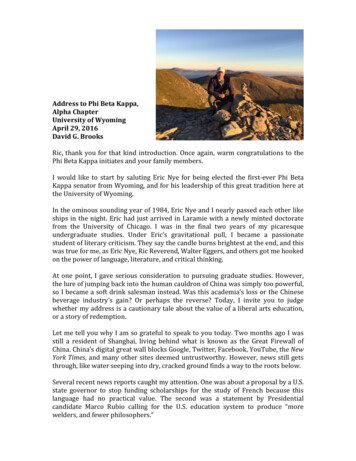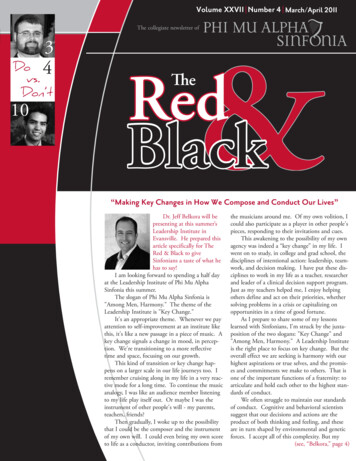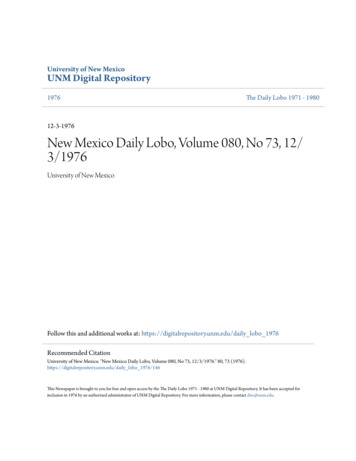
Transcription
IB MATHEMATICS SLPhi and the Fibonacci Sequence in Art
1Table of ContentsIntroduction2Overview2The Fibonacci Numbers3The Fibonacci Numbers and the Golden Ratio4The Fibonacci Spiral6The Phi Matrix9Reflection11
2INTRODUCTIONThis investigation will be focused on exploring the Golden Ratio, also known as phi, andits correlation to the Fibonacci sequence, as well as its presence in famous architecture andartwork.In order to explore the relationship of the Golden Ratio and the Fibonacci sequence, I willbe using a variety of rounded ratios, functions, identities and geometric shapes to find mycalculations. Once I have explored the correlation between the two, I will use this acquiredknowledge to connect the mathematics with artistic renderings of the ratio. For example, thisprinciple is commonly expressed to be found in famous artworks such as Leonardo Da Vinci's“The Last Supper”. I predict that the majority of appealing architecture and artwork that I selectto analyze will use the Golden Ratio and Fibonacci sequence. The importance of the GoldenMean in art is significant to me as a scholar because I take HL Art and art is a subject I amparticularly passionate about. It would also be interesting to learn how the mathematicaltechniques and compositions of famous artists could be used in order to make my own artworkeven more successful. The aim of this investigation would also be to better my own artwork andunderstand what elementsOVERVIEWThe Golden Ratio is an “extreme mean and ratio” that can be found in organic forms innature as well as in mathematical forms. The Golden Ratio is believed to produce the mostsatisfying and attractive shapes and compositions, which is why a large number of artists andarchitects have employed this principle in their creations. It is defined as the geometricrelationship in which two quantities have a ratio equal to the ratio of their sum to the largestquantity. A common way to represent the ratio is by drawing a line segment and dividing it intotwo smaller segments labeled a and b, a being the longer portion. The ratio of a to b should beequal to a b divided by a. This value, phi, is best known as approximately 1.618, however it isan irrational value that continues infinitely.Similarly, the Fibonacci Sequence is an infinite sequence of integers that are calculatedby finding the sum of the two numbers before it, with the exception of the first two integers. Forexample, 1,1, 2, 3, 5, 8 and 13 are the first 7 Fibonacci Numbers because 1 2 3, 2 3 5, 3 5 8and so on. This sequence relates to the Golden Ratio because it can be presumed that the ratio of5 to 8, is approximately equal to the ratio of 8 to 13. In other words, the Fibonacci Numberscontinue to approach the Golden Ratio as their limit progresses. There are many ways to observethis relationship, such as algebra, geometry, precalculus and calculus, some of which will bepresent and analyzed in this assessment.
3The Fibonacci NumbersThe Fibonacci Sequence, as described above, is commonly represented using the first 10or so numbers, (0,1,1,2,3,5,8,13,21,34) because the sequence begins to escalate very quickly. Inorder to calculate the rest of the numbers more efficiently, there are multiple equations that canbe used. It is commonly observed that as the term grows larger, the ratio of a fibonacci number toits predecessor approaches phi closer and closer.n1so f (1) 1.618 0.723592 151/2This equation uses n to find the nth term of the sequence, where phi is equal to 1.618. However,when n 0, the equation will be equal to 0, which would mean that 0 is not a term in thesequence. In order to consider 0 as a term in the sequence, a modified equation (below) must beused.nf (n) PPhihi 2In this equation, if n 1, f(1) 0. It is important to consider 0 as a term because the sequenceotherwise starts as 1,1,2 but 0 1 1, and 1 can’t spontaneously create a duplicate of itself.Consequently, the 2nd and 3rd terms should be 1, and the 4th term is 2, which is proved below.f (n) f (2) f (3) f (4) P hi51/24P hiP hi 23P hiP hi 24P hiP hi 22so f (2) so f (3) so f (4) 1.6181.618 231.6181.618 241.6181.618 2f (2) 0.72358 1f (3) 1.17076 1f (4) 1.89429 2Below are the first 50 terms in the fibonacci sequence. After calculating them, they will be usedto show their increasing approach to phi, 1.618033988749895.TABLE 1: The First 50 Fibonacci 5,986507,778,742,049
4Fibonacci Numbers and the Golden RatioLeonardo Fibonacci discovered this sequence of numbers in 1202 AD and deemed it tobe an extremely important foundation for the relationship behind the golden ratio. In order tocalculate phi, you simply take any term of the sequence and divide it by the number before it. Itis important to note that the ratio of the first few terms won’t be as close to 1.618 as greaterterms because they must begin to gradually approach the limit. This could be represented by theequation below.f (n 1)f (15)377sof (n)f (14) 233 1.61803TABLE 2: The Fibonacci Numbers in Relation to PhiPosition in thesequenceCorrespondingFibonacci NumberRatio of a Fibonacci number toits Previous NumberThe difference of theFibonacci Number from 02142331.618055555555560-0.000021566805666
0,3521.6180339887498900.000000000000000
6Fibonacci Numbers in ArtThe Fibonacci SpiralThe Fibonacci Spiral is a unique logarithmic spiral because every turn of π2 is in exactincrements of 1.618, thus creating a perfect golden ratio form. This spiral is commonlycomposed of squares with side lengths of the fibonacci numbers (1,2,3,5,8,13,21,etc.) and can befound in nature and in a variety of famous artworks. In art, the composition of a painting isextremely important to the success of the overall piece, which is why many artists try to use thegolden ratio to ensure effective subject placement. An example of this can be seen below as wellas in a still life by George Weissbort entitled The White Coffee Pot with Fruit and Wine, w herethe wine glass and pears fit perfectly into the spiral.In order to further understand the characteristics of the Fibonacci spiral (prior to applying it toany artwork), I analyzed the dimensions of a template that is provided on the official site of thegolden ratio by putting itinto a graphing programand plotting the points.Like the picture above,the rectangle that thespiral depends on iscomposed of squareswith side lengths thatcorrespond to numbersin the sequence. Eachelement of the rectangleneeds to follow the
7golden ratio in order for the spiral to be perfect, since it is a logarithmic spiral with a growthfactor of phi, 1.618. However, using the rectangles and squares with the golden ratio proportionsto form the spiral only gives an almost accurate representation since the actual function wouldneed to be graphed. Assuming that the picture is slightly distorted, the square DEFA has relativeside lengths of around 7.4 cm, which is close enough to the 7th value of the series, 8. Theslightly smaller square, MKBF, has side lengths that can be rounded up to 5, which is the 6thFibonacci number. Continuing with this pattern, the smaller square, GLKJ, has side lengthsslightly under 3, square EGHI has side lengths at approximately 2 and so on. However, the actualproperty of the golden ratio can be identified when the length/width of the overall rectangle isdivided by the side lengths of the squares that share its perimeter. For example, the rectangle’sside length AB,12, is segmented by the side length FB, 4.57 cm, and AF, 7.43 cm. According tothe divine proportion, the ratio of a (being the longer segment: 7.43) to b (4.57), should be equalto the ratio of the entire side length (a b 12) to a, which is almost exactly true.a 7.43b 4.57 1.62a b 12a 7.43 1.615This also occurs in the width of the rectangle as well:KBLK 4.612.79 1.65LBKB 7.44.61 1.60And also within the smaller rectangles:GLEG 2.841.75 1.62EL 2.84 1.75GL 4.592.84 1.62These simple ratios prove that the spiral in the template does correspond with the divineproportions.It is commonly believed that the golden spiral is actually hardwired into our brains andthat we are always subconsciously using it to determine the beauty of a person or an object. Thecloser something is to being proportional to the spiral, the more visually appealing it is to theeye. In fact, the golden spiral is actually extremely prevalent in nature and therefore wouldprobably be most successful in judging the proportions of organic form. Examples of this wouldbe shells, human body parts, and other naturally occurring shapes. Since this internal assessmentfocuses on the presence of phi in art, I wanted to put one of my own IB artworks to the test.
8For my IB Visual Art exhibition, I was inspired by therhythm of repetition and created this piece which focuseson the unique shape of the human ear. During the process,I had not even thought about the golden ratio or itsapplications to a composition, but since the subject is anaturally occurring form, it is likely that the golden spiralcan be identified in my artwork. This piece was sosuccessful that it ended up receiving a superior rating at astate art competition. Surely, its visual appeal could beattributed to an underlying mathematical foundation.I put this image into the graphing software that I had been using to analyze the goldenspiral and positioned the template over my artwork. I found that the spiral fits perfectly into thelower crevice of the purple ear hole, when the outside curve is aligned with the helix. The bottomline of the rectangle is also almost exactly lined up with the bottom of the other two ear holesand the curve of the ears seems to follow the outermost curve of the spiral. Also notable are theyellow lines that I graphed where I saw significant elements in the artwork. The horizontal line atapproximately y 6.8 is the point at which the ear lobes blend into each other and the colorsmeet, while the vertical line at about x 13.7 is an extension of the length of the square in thetemplate. Interestingly enough, if the measurements of the segments these lines created are takenand put into a ratio, the quotientis extremely close to the goldenratio. This reinforces the fact thatthe artwork successfullycorrelates to the golden spiral andextreme mean, which couldexplain why it was such a strongpiece.The ratio of the width to thelower point where the colors17.75merge: LAJL 10.98 1.617The ratio of the width to thesquare of the spiral template:ADAO 22.3713.47 1.66
9The Phi MatrixThe phi matrix is a rectangle composed of manydifferent parts which all adhere to the divineproportions. This diagram is commonly used todetermine the focal point of something in relation to therest of the composition. Like the golden spiral, Igraphed the points of the sections of the phi matrix andtook measurements to understand how exactly thegolden ratio is involved in this template. It becameclear that, once again, every line andline segment ratio ended up beingapproximately equivalent to phi. Inaddition, the area of the rectanglesor squares could be rounded to get anumber in the fibonacci sequencesuch as: NRBF, AEMQ, PLGJ, andDCOK have an area of 5 c m 2 ,KLNM has an area of 2 c m 2 , andPLKO, LGFN, DKME and MNRQhave an area of 3 c m 2 . This createsan interesting pattern of values thatfollows the progression of theFibonacci numbers from the centeroutwards. Also, the center portionsare measured to be the same distance from each side, which allows for there to be two differentratios for every series of segments that should be equivalent to each other.Width:CEEA 2.781.71 1.63ADDC 2.791.70 1.64CACE 4.492.78 1.62CADA 4.492.79 1.61All the line segments are extremely close in value, representing how the golden ratio andsymmetry are used in the matrix.Length:CPPJ 4.512.75 1.64JOOC 4.482.78 1.61CJCP 7.264.51 1.61CJJO 7.264.48 1.62Since the phi matrix seems to be centered around the rectangle KLNM, it can be easily inferredthat a most successful composition would have a focal point or a large portion of the subjectwithin that area. Upon initial research, one of the artworks that is said to utilize very clear divineproportions is Salvador Dali’s The Sacrament of the Last Supper. N ot only did Dali actually
10frame his artwork in a golden rectangle, he also is said to have positioned the table perfectly tocreate the extreme mean, and used a large “dodecahedron” in the background because of itsconsistency with phi. As for my analysis, I lined up the lower line of the matrix to the table andmeasured the distances to create my own scaled down ratios. It is also clear in this graph thatJesus, the focal point, is entirely within the center section of the matrix, which explains why theeye is automatically drawn to him. This famous painting is pleasing for a multitude of otherreasons not related to mathematics, but the golden ratio is undoubtedly present here, and waslikely used on purpose to symbolize the perfection of the religious scene.The actual canvas is 166.7 cm x 267cm, while this image is 11.71 cm x18 cm.The width is scaled by afactor of 14.236 and the length isscaled by a factor of 14.833.Ratio of table to the area abovetable to the table:IA7.28AG ( 4.43 ) 1.64Ratio of area above table to entire11.71canvas: IBIA 14.236 ( 7.28 ) 1.61The Sacrament of the Last Supper is an artwork that is frequently used as an example torepresent the golden ratio in artwork, but I wanted to see if other famous artworks not presentemploy this design as well. It is safe to assume that, if an artwork is well known and loved, and ifthe golden ratio is extremely attractive to the eye, the artwork may in turn contain phi. Thispainting, however, is also pleasing because of the realist style, but can an abstract piece be just asvisually appealing?This artwork, Composition VII, by WassilyKandinsky is actually deemed to be one of the mostinfluential artworks in the history, since itcompletely changed the perception of abstraction.Although there are a great deal of vibrant shapesand chaos, the painting has a very clear focal pointwhich captures the attention of the audience. In mygraph, I have plotted points around this form.
11The amorphous shape that is shadedhere in green seems to have themost emphasis since it has such adistinct black outline and is almosta different style than the rest of theforms. Instead of applying thetemplate to the artwork, I used thesquare I plotted and graphed twohorizontal lines similar to the onesin the matrix. These ended up beingat about y 5.9 and y 3.3. Next, Irepeated the same process and tookthe measurements of the segmentsproduced by the lines and thecanvas. Although roughly estimatedand obviously not symmetrical, the segments I created actually proved to create overall canvasratios with quotients relatively close to 1.618.BFBN 9.726.44 1.51 orBFMF 9.725.82 1.67From these observations, the presence of the golden ratio can be identified in even this abstractpiece with no real subject matter, and is likely responsible for why it is so satisfying to view. It isalso probable that many other famous artworks not used as examples have some similarities tothe divine proportion in either the golden spiral or phi matrix. While there are many other waysto identify the extreme mean in design and art, I found that these two diagrams seemed to be themost common and effective in comparing composition.ReflectionThis investigation was inspired by my love for art as well as my interest in the goldenratio, which is a concept I had never fully understood despite my art teacher constantly advisingus to use it. Although there is not a lot of complex math involved in understanding and locatingthe ratios, the concept can be difficult to grasp, so it was definitely beneficial to have done somuch research. I found it extremely interesting that one of my most successful artworks works sowell with the golden spiral and I had not even known that I was using it. The power of the mindis that I can subconsciously use mathematics in something I thought was purely emotional, andthat it is responsible for a portion of the aesthetic beauty I was able to produce. Although phi andthe golden ratio isn’t completely understood despite being around and studied for centuries, thisinvestigation proved to be extremely interesting and will be beneficial even after its completion.
12Works Cited(n.d.). Retrieved March 27, 2018, from https://www.goldennumber.net/fibonacci-series/50 Most popular paintings. (n.d.). Retrieved March 27, 2018, 944.phpBourne, M. (n.d.). Golden Spiral. Retrieved March 27, 2018, n-spiral-6512Famous Abstract Paintings That Changed The Way We Perceive Art. (n.d.). Retrieved March27, 2018, 1-famous-abstract-paintings.htmlGeoGebra Graphing Calculator. (n.d.). Retrieved March 27, 2018, fromhttps://www.geogebra.org/graphingKangas, B. (2014, November 15). Exploring Dali's Sacrament of the Last Supper. RetrievedMarch 27, 2018, lKnott, R. (n.d.). Retrieved March 27, 2018, nott/Fibonacci/fibInArt.html#archMost Memorable Golden Ratio Examples in Modern Art. (n.d.). Retrieved March 27, 2018,from -architecture-music/The Fibonacci Sequence in Artistic Composition. (n.d.). Retrieved March 27, 2018, -fibonacci-sequence-in-artistic-composition/
IB MATHEMATICS SL Phi and the Fibonacci Sequence in Art . 1 Table of Contents Introduction 2 Overview 2 The Fibonacci Numbers 3 The Fibonacci Numbers and the Golden Ratio 4 The Fibonacci










